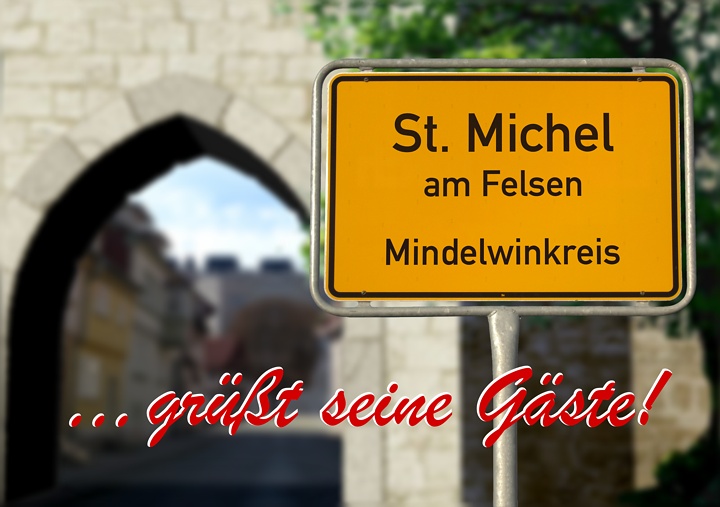
Here you see some pictures that did’t fit into any of the other categories. The newest are on top.
Computer based work, 1,241 · 874 square pixels (DIN A 6 at 300 dpi), 2015. — A greeting card from St. Michel am Felsen. The shot was taken in front of the Mühltor (“Mill Gate”) in the east of the city.

Watercolour, 20.5 · 28.5 cm², 2014. — From a Gothic steeple high above the city of St. Michel am Felsen, a brass band musically proclaims the Gospel. (For a detailed description, see my below preliminary sketch for this picture.) Real and fictitious examples have been:
and not least — as the painting resumes my series of tolkienesque pictures —

Computer based work, 518 · 487 square pixels, 2012. — Initials with figures inside are called “inhabited initials.” This illustration here is a previous version of a miniature created to decorate a text sample for my font Pfeffer Simpelgotisch. Alas, it was somewhat too fine for its small size. The depicted man with the laptop is the one who normally uses to play backgammon with Mr Goeli.
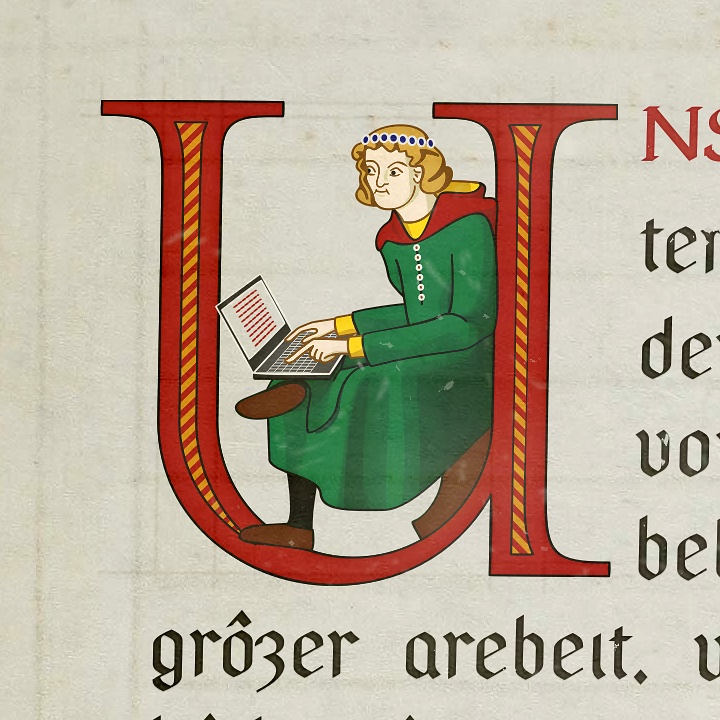

Computer based work, 49 · 71 mm², 2011. — An Exlibris for my books. In principle, a self portrait as well. This, by the way, is my concept of a nice library. The vanishing points are calculated as described here. Perspectival illusion is perfect when the eye is held about thrice the image’s width before that spot where the gown’s end meets the calf. The fonts used in this picture are Georgia, Verdana and Wilhelm Klingspor Gotisch.
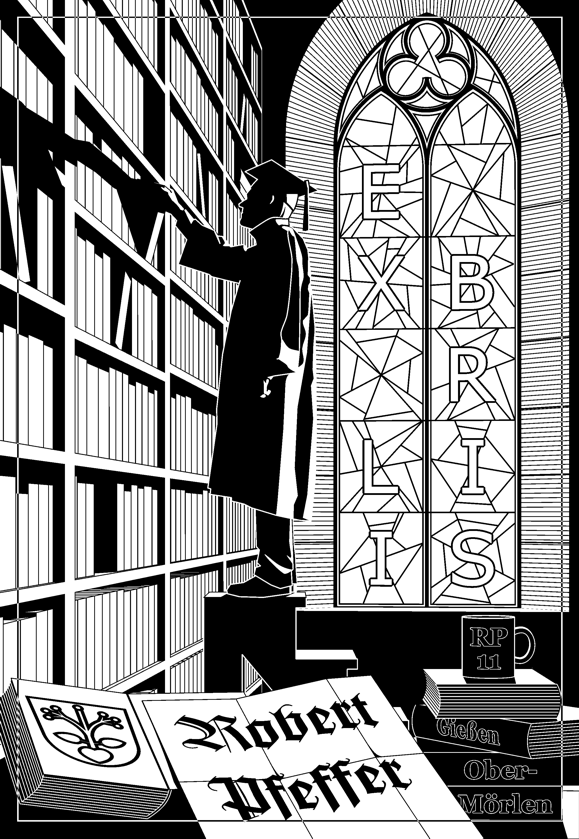

Computer based work, 15 · 22 cm², 2011. — Apparently, already a hundred years before my below drawing somebody depicted the cave hounds of mount Winterstein in the same manner as I’ve done. And Georg Meisenbach, inventor of the glass engraving halftone print (or rather his company, see the lettering at the bottom right in the image), made the plate for it — or at least that’s the way it seems. The TV tower on the Steinkopf hadn’t yet been built then, of course.

Pencil, 17 · 26 cm², finished in 2011. — Another picture of mount Winterstein near Ober-Mörlen, in addition to my previous painting “Mörlis”. To the left you see one of the entries to that subterraneous city; in these entries now live cave hounds. These are nasty and always hungry creatures, feeding on any prey they can seize with their “jaws that bite”, their “claws that catch”. When they aren’t chasing lone wanderers, they also like to catch children from promenading families. Besides the Hound of the Baskervilles (which I only know from hearsay) a scene from the game Tomb Raider I (which I also almost only know from hearsay) served me as inspiration, namely that scene at the very beginning in Peru.

Pencil, DIN A ;4, 2010. — This sketch offers a preview of a planned watercolour painting. From a gothic steeple high above a terraced city on the slope of a hill, a corps of trumpeters is tunefully proclaiming the Gospel. It’s thaw on a moist and dull day at the beginning or the end of winter. The sun is shimmering softly from the upper right unto the trumpeters, making the cross on top of the banner gleam, while in the background some light beams hit the ground. Patches of snow remain in the streets and the landscape in the background, but no fresh snow will stay. The houses are built from travertine and mostly slate tiled (as are the churches and fortifications of Mühlhausen in Thuringia); sporadically, you also see timber framing. The angel statue at the steeple (being not really typical for German Gothic style, rather to be encountered in French and Italian Gothic) is modelled after August Schreitmüller’s sculpture “Die Güte” (“Gratiousness”) at the Dresden City Hall Tower. The tree is a brumally bleak walnut tree. The city shall still become somewhat farther and wider. Towers like the “Witch’s Tower” in Idstein or the “Plump Tower” in Friedberg shall have a counterpart here.
This image is to continue my series of ‘tolkienesque pictures’. Inspiration came from this depiction of the city of Minas Tirith as well as from this one by John Howe.
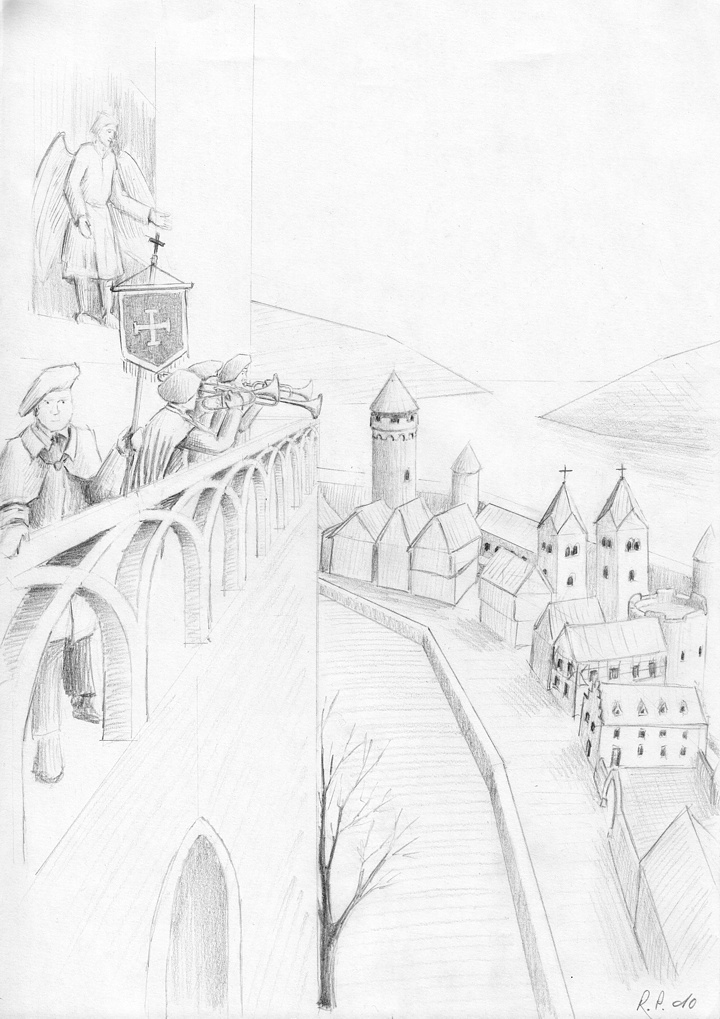

Computer based work, 200 · 500 square pixels, 2010. — Modelled after the sandstone sculpture of Charlemagne in front of the historic museum in Frankfurt am Main. Aim was to make it look like the bronze statue of Wulflas which I use (together with this one) for illustration of my website’s font section.
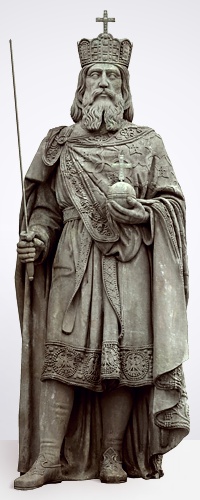

Watercolour, 37 · 27 cm², finished in 2010. — Mount Winterstein near my hometown Ober-Mörlen, displayed in cross-section and highly simplified. Beneath lies an ancient, subterraneous city. It was built by Hyperboreans towards the end of the last ice age. The lava ducts seem to be part of an experimental lava-hydraulic energy system the purpose of which isn’t fully explained yet. Apparently, the experiment failed and all were killed. The city has been discovered in the course of mining activities at the end of the 19th century (see top right). Obviously, the discoverers were so impressed by their find that they remained silent about it all their life. This is the full truth, I’ve invented it all by myself! Source of inspiration was the old computer game Indiana Jones and the Fate of Atlantis, which I used to play enthusiastically during my early youth. In nearby analogy, my wife has named the city “Mörlis.”

Watercolour, 29 · 22 cm², 2001. — Germany, not as beautiful it is, but as it ought to be. Antetype for the bridge to the right was the Göltzschtal Viaduct in Saxony. For the rest I’ve had the landscape around the Lahn river between Weilburg and Runkel in mind.

Watercolour, 24 · 15 ½ cm², 1999. — Ought to have become some sort of allegory; what exactly, I don’t quite know myself. The name “Ganymede” was chosen simply because I liked it, not because I put emphasis on its significance in Greek mythology.

Watercolour, 24 ½ · 10 cm², 1999. — Once served as an illustration for a previous page on my hunting hobby.

Watercolour, DIN A 4, 1998. — A fantasy picture. Whoever (as a better connoisseur of horses than I am) thinks he detects errors in anatomy, bridle, or the way the reins are held, must be mistaken: That’s just how it is with a pegasus. The crosses on the wings come from my favourite aircraft, the German biplanes of World War I.

Watercolour, DIN A 4, 1997. — The continuation of the subject from the previous picture, but this time from the opposite perspective.

Watercolour, DIN A 4, 1997. — This was my second watercolour picture. (The first was a less exhibit-worthy attempt, which I no longer own.) At some point in senior art classes, watercolour painting became the subject, and the assigned topic was “Man and Space.” So all I did was depict a man in space. To make it especially impressive, I chose to depict a particularly impressive — superior, superhuman, gigantic — man: Adloff the Gigantic. The name “Adloff” comes from a figure that appeared to me in a dream: Adloff Uffbruchlokal, the ugly innkeeper of a rundown tavern. Unlike the figure shown here, he resembled Mampf from the Knax characters. “OPQR” stands for the letters of the alphabet between N and S.

Pencil, 19 · 24 cm², 1997. — One of the cherubim who, according to Genesis 3:24, bar the entry to the Garden of Eden. Together with the previous one and other pieces, this picture was meant to be part of a collage on “angels” in my art class.
“… the angel guards the gate no more, to God our thanks we pay.”

Pencil, 21 · 30 cm², 1997. — A preparatory sketch for a never-completed pencil drawing from my senior art classes, which was supposed to become part of a collage on the theme of “angels” together with the above drawing. It shows the ‘fallen angel’ Lucifer just after being defeated by St. Michael the Archangel.
